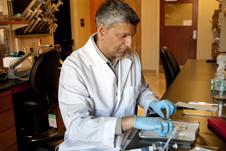If you've ever tried to warn teenagers of the consequences of risky behavior — only to have them sigh and roll their eyes — don't blame them.
Blame their brain anatomy.
Sociologists and psychologists have long known that teen brains are predisposed to downplay risk, act impulsively and be undaunted by the threat of punishment. But now scientists are beginning to understand why.
"I think teenage behavior is probably the most misunderstood of any age group — not only by parents but by teenagers themselves," says Pradeep Bhide, a Florida State University College of Medicine neuroscientist and director of the Center for Brain Repair.
"It's a critical time in life, and a very stressful one, when they are going through so many changes at the same time that their brains are changing. The teen years are actually a very busy time for brain development."
During the past year, Bhide brought together some of the world's foremost brain researchers in a quest to explain why teenagers — and male teens in particular — often behave erratically. He and two Cornell University colleagues examined 20 of the leading research projects from brain experts around the world and recently published their findings in a special volume of the scientific journal Developmental Neuroscience.
What they found surprised them — not so much because of the behavior uncovered, but because of how much of it was explained by brain development, or lack thereof.
Unlike children or adults, for instance, teenage boys show enhanced activity in the part of the brain responsible for emotions when confronted with a threat, making the threat more difficult to ignore. In one study, even when the teens were specifically told not to respond to a threat, many could not stop themselves. Magnetic-resonance-scanner readings revealed their brain activity was strikingly different from that in adult men.
In the past decade, Bhide says, technological advances in such imaging have shed new light on what goes on inside our heads. Now researchers essentially can watch an individual's brain in action as it responds to various stimuli.
"This field has exploded," he says. "Psychologists, psychiatrists, educators, neuroscientists, criminal-justice professionals and parents are engaged in a daily struggle to understand and solve the enigma of teenage risky behaviors," Bhide said. "Such behaviors impact not only the teenagers who obviously put themselves at serious and lasting risk, but also families and societies in general."
Soldiers and first responders — as well as terrorists — are often teenage males and young men willing to put themselves in harm's way.
From an evolutionary standpoint, some theorize, such risk-taking may have been necessary to hunt, fend off danger or even compete for a mate.
"If you compare the same person as a teenager and then later as an adult, they will still tend to be more impulsive as a teenager," Bhide says. "And different parts of the brain develop on a different timetable."
All species that humans have studied begin their existence with a period of rapid brain development. For humans, brain growth inside the womb and during the first three years of life occurs at a phenomenal rate in both overall brain size and the number of pathways developed.
But as people get older, some of those pathways sort of fall by the wayside while others become major thoroughfares. The teen years, Bhide says, are an especially busy time for that process.
"The body's hormones have a pretty big effect on the brain as well," Bhide says. "And of course it's different for females and males. But, for instance, schizophrenia and certain other mental disorders appear during this time for that reason."
Teen brains also may be more susceptible to lasting damage from drugs and alcohol ingested during that brain-remodeling process — although Bhide says researchers are still looking at that issue. "What we do know is that the damage is different."
Regardless, few of us will be the same person at 47 that we were at 17, a fact you may find comforting.
"I'm always reminded of a quote from Mark Twain," Bhide says. "'When I was a boy of 14, my father was so ignorant I could hardly stand to have the old man around. But when I got to be 21, I was astonished at how much he had learned.'"





.png)
